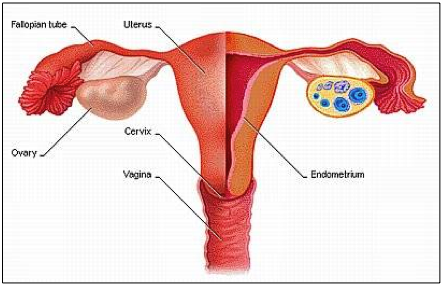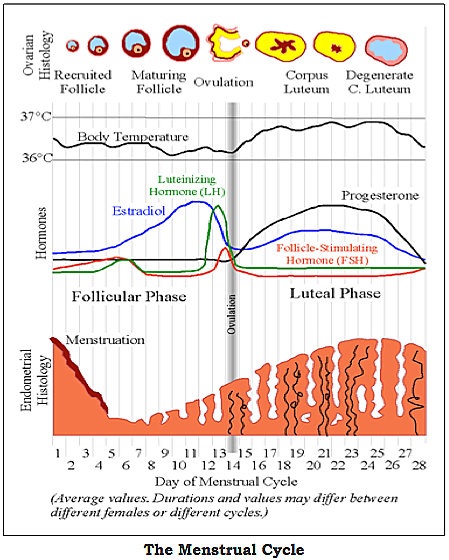Let’s Talk!
For most women in their childbearing years, menstruation is an expected monthly event. You are familiar with some of the signs and symptoms associated with your period, but you may be unaware of the complex physiological mechanisms behind them.
The word “menstruation” is derived from the Latin “mensis” and relates to the fact that it takes close to 28 days for the moon to revolve around the Earth. Most women have their first menstruation around age 12 (menarche) and stop menstruating by age 55 (menopause).
The ovaries, uterus (endometrium), fallopian tube, egg/follicle, and corpus luteum are the organs involved in the menstrual (see picture below). The average length of the menstrual cycle is 28 days. The cycle is divided into three parts: the follicular phase, ovulation, and the luteal phase. Ovulation is the event that allows the transition from the follicular phase to the luteal phase.
The menstrual cycle starts with menstruation (see diagram below). Therefore, the first day of your menstruation is day (1). The menstrual flow usually lasts 3 to 5 days and the average blood loss is 35 mL. Most women experience cramps in the abdomen, back, and upper thighs during the first few days of their menstruation.
The follicular phase begins on day (1) of the cycle and lasts until day (14). Consequently, menstruation is part of the follicular phase. The hypothalamus (a gland in the brain just above the brain stem) produces the hormone Gonadotropin-Releasing Hormone (GnRH). GnRH stimulates the pituitary gland that is at the base of the brain.
The pituitary gland in turn releases (2) hormones: Follicle Stimulating Hormone (FSH) and Luteinizing Hormone (LH). FSH and LH go into the bloodstream and stimulate the ovary. The ovary responds by producing the hormones estrogen (due to FSH) and progesterone (due to LH).
The follicular phase is the time when the follicle in the ovary develops and the lining of the uterus (i.e., the endometrium) starts building up. The follicle gets bigger because it is stimulated by the Follicle Stimulating Hormone (FSH).
Around day (10), the level of estrogen in the blood becomes too high. To lower that level, the hypothalamus signals the pituitary gland to turn down the production of both FSH (responsible for estrogen) and LH (responsible for progesterone). But, the pituitary gland is only able to reduce the level of estrogen in the blood, not that of progesterone. This is due to the fact that ovulation has not yet occurred and the corpus luteum is needed to create a negative feedback loop.
Ovulation is a one-time event that occurs around day (14) because of the very high level of progesterone produced by LH. The follicle breaks open, and an egg is released into the fallopian tube. The remains of the follicle stay in the ovary and become the corpus luteum. If the egg is not fertilized within a day, it will dissolve in the fallopian tube.
The luteal phase begins on day (14) and lasts until day (28). LH stimulates the corpus luteum left in the ovary and it, in turn, starts producing estrogen and progesterone which accelerates the thickening of the endometrium. Sensing the rise of progesterone in the blood, the hypothalamus signals the pituitary gland to stop the output of LH.
The reduction of LH causes the corpus luteum to degenerate. As the corpus luteum is degenerating, it no longer produces estrogen and progesterone. Near the end of the luteal phase, there is a marked drop in both of these hormones which causes the endometrium to shed. Menstruation is the shedding of the uterine lining because the egg was not fertilized.
The menstrual cycle is a complex series of physiological changes. Although it may be difficult to grasp, it is important to review this information so that you can better understand your own body during your childbearing years.
Literary Truths
Here are suggestions to familiarize yourself with your menstrual cycle (if you are NOT using a hormonal birth control method):
- Mark your period on a calendar: this will give you an idea if you are regular from one menstrual cycle to the next. Also, it can indicate if you are at risk for anemia should you bleed for more than 7 days in a row.
- Learn about the hormonal changes of the menstrual cycle: the physiological changes that happen during this cycle can be difficult to understand. You may have to review the information a few times in order to grasp the detailed picture.
- Pay attention to certain signs and symptoms: throughout your menstrual cycle, you may feel different. By noticing changes in your body, you may be able to predict your period and when you are fertile.
- Consult your family doctor: if you are unsure if your menstrual cycle is normal, your GP may be the best person to ask because s/he knows your medical history.
- Research different methods of birth control: it is important to know how to prevent fertilization and if/how these methods affect your menstrual cycle.
Truth in Motion
References
Baerwald AR, Adams GP, Pierson RA. A new model for ovarian follicular development during the human menstrual cycle. Fertil Steril. 2003; 80:116-122.
Female sexual organs
Menstruation and the Menstrual Cycle
Side of Ovulation and cycle characteristics in normally fertile women
The Ovum


I read books for a while, but now I read great blogs. Your place is one of the examples why I began to pay attention to internet resources. Good luck!
Hi,
I ran across this website by mistake. I can say that your site is really helpful. Furthermore, I love the theme – it’s amazing! Right now I don’t have a whole lot of time to read all of your posts, but I have bookmarked your site, and also signed up for your RSS feeds. Many thanks for an incredible site.
I came across your site on digg the other day, and really loved the blog. I’ve now bookmarked it, and will be back later.
I really like your blog, and appreciate the excellent quality of the content you have here.
Peace,
Klara
I’m happy that I noticed this blog – precisely the kind of information that I was looking for!
I’m glad that I found this website, precisely the right info that I was searching for!
This info is just what I was searching for. It would be fantastic to see you write more on this topic…Will come back to see.
Fantastic post and thanks for sharing.
Great blog! I’ve bookmarked it, and I’ll be back to read more in the future.
What a great resource!
What a great blog and informative posts! I will bookmark your site. Have an awesome day!
Interesting read. I appreciate your hard work. Have a great day!
I need to post a comment to say thank you for this marvelous article. It is simply remarkably generous of you to give for free what most people might have distributed as an e-book to make some money. This strategy works because you understand that other people just like myself really want to learn more about this subject.
Pingback: Burberry handbags
Very interesting; thank you for sharing!
Carry on the excellent work. I’ve incorporated your website to my blogroll. I think it will improve the value of my website 🙂
That’s a nice piece of information, kinda refreshing for my brain.
I know this is truly boring and you’re going to skip to the next comment, but I just wanted to throw you a big thanks – you cleared up some things for me!
I’m very excited about your next post. Thanks again for making such high quality content.
I’ve been surfing online for more than three hours today, yet I never found any interesting article like yours. Your blog was worth my time. In my view, if all web owners and bloggers made good content as you do, the net would be a lot more useful.